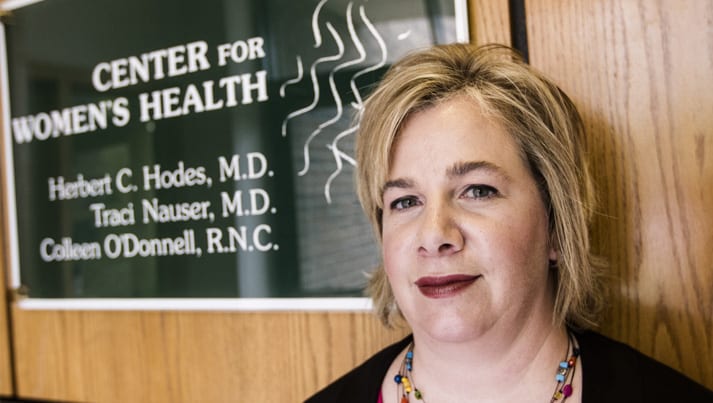47 Pages of Intrusion

Dr. Traci Nauser didn’t go to medical school so she could become a reproductive rights activist, and for most of her career she has been able to focus on doing the job she loves: being an OB/GYN. “I was able to stay out of the limelight and just take care of patients,” delivering healthy babies to healthy mothers and helping women make informed, safe decisions about their reproductive health and future—”until Kansas elected Governor Brownback,” she says.
The latest assault on reproductive rights signed by Brownback, in April, is 47 pages long and packed with onerous and absurd restrictions on abortion providers. The new law does more than place barriers between women and their reproductive rights—it puts their health in grave danger. The Center filed its challenge to the entire law just a couple weeks ago, the latest battle we’ll wage standing with Dr. Nauser and her medical partner and father, Dr. Herbert Hodes.
One of the law’s measures seeks to change the circumstances under which a woman can have an emergency abortion. Under the law, if the doctor has two minutes to determine how far along the pregnancy has advanced, and thus make an informed decision about how to proceed, then the situation is not considered an emergency. As a result, doctors may not bypass the state’s 24-hour waiting period requirement or other time-consuming restrictions, even if a woman is hemorrhaging, suffering from a serious infection, or facing an ectopic pregnancy about to rupture. The new law makes emergency abortions—in which the life of a woman can depend on the immediate termination of her pregnancy—effectively illegal.
Another restriction in the new law requires doctors to tell patients that undergoing an abortion increases the risk of breast cancer. This so-called “informed consent” measure has become a popular ploy by our opposition as they hammer away at reproductive freedom. The problem? The information doctors have to convey isn’t true. But in Kansas, the anti-choice politicians took it a step further, requiring doctors to falsely affirm the authenticity of the state-mandated language.
“With this law they’re actually going to make me lie to patients, which is completely unethical,” says Nauser. It’s also a threat to the patient-doctor relationship. The National Cancer Institute flatly rejected the “theory” of heightened breast cancer risk when it released study findings indicating that “induced abortion is not linked to an increase in breast cancer risk.” As Dr. Nauser explains, the scare tactic is based on the evidence there may be a connection between hormones released during pregnancy and reduced risk of breast cancer. By this twisted logic, anything that prevents pregnancy, such as condom use or abstinence, increases the risk of cancer.
These two measures represent a fraction of the restrictions designed to throw up barriers between women and reproductive health care. The law also includes a personhood clause, new taxes on abortions and abortion providers, restrictions on abortion providers volunteering in schools, and the elimination of exceptions in cases of rape and incest.
Over the years, Dr. Nauser and her father have seen more than their share of onerous requirements placed on abortion providers—the 24-hour waiting period, the patronizing requirement to offer the patient a photo of her ultrasound, a sham licensing procedure aimed solely at regulating reproductive health care providers out of practice. With each new regulation they have had to adapt their procedures in order to keep the state from shutting her clinic down. “We’ve adjusted, but that’s not the point,” she says. “That’s not part of taking care of patients. That’s not what doctors do.”
What every doctor should be able to do is offer patients the best possible care without interference from the government. A federal judge has already stepped in to stop the two most egregious provisions of this law, ensuring for now that women have access to emergency abortion care without delay and that doctors don’t have to lie patients about the care they need.
What the Center does, and will continue to do, is protect doctors’ rights to practice the way they’ve been trained, and safeguard a woman’s right to the best care for her and her family.
